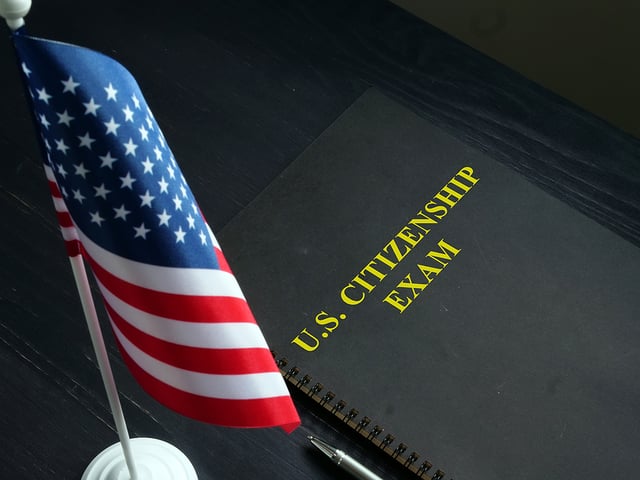
Writing on the U.S. Citizenship Test
Applying to be a U.S. citizen is a long and complex journey. By the time you get to the testing portion, the hardest parts of gathering paperwork and documentation are behind you. Now it’s just the test and the waiting.
About the Entire Test
As you probably know, the U.S. Naturalization (or Citizenship) Test has three sections: U.S. History and Civics, Reading in English, and Writing in English. When you go in for your interview with an immigration officer, he or she may conduct these tests in any order. To pass, you must answer six out of ten questions relating to U.S. history and civics correctly, in addition to one reading question and one writing question. The test is oral, except for the writing part. Here’s what you need to know about that.
The Writing Part of the Test
The immigration officer will speak a sentence and ask you to write it down. The sentence is likely to use some of the vocabulary referenced in the list of Writing Vocabulary for the Naturalization Test. The sentence will be about U.S. history or civics. You will need to listen carefully to the sentence and then write it down on the piece of paper provided. Do your best to write down every word in the sentence. Skipping or omitting a word may make the sentence incoherent and you will not pass. You may ask the officer to repeat the sentence so that you can hear it again. While spelling does not have to be perfect, the sentence must be legible and understandable to the officer and the words on the writing vocabulary list should be spelled correctly. If there are words missing or you write down the wrong words, you may be asked to try again with another sentence. You have up to three opportunities to correctly write down the sentence the officer speaks to you.
The Words Used
This is the official list of vocabulary words likely to be used in the writing portion of the test. Before you go in for your interview, make sure that you review these words and practice spelling them.
| People | Civics | Places | Months | Holidays | Verbs | Other (function) |
Other (content) |
|---|---|---|---|---|---|---|---|
| Adams | American Indians |
Alaska | February | Presidents’ Day |
can | and | blue |
| Lincoln | capital | California | May | Memorial Day |
come | during | dollar bill |
| Washington | citizens | Canada | June | Flag Day |
elect | for | fifty 50 |
| Civil War | Delaware | July | Independence Day |
have has |
here | first | |
| Congress | Mexico | September | Labor Day | is was be |
in | largest | |
| Father of Our Country |
New York City |
October | Columbus Day |
lives lived |
of | most | |
| flag | United States |
November | Thanksgiving | meets | on | north | |
| free | Washington | pay | the | one | |||
| freedom of speech |
Washington, D.C. |
vote | to | one hundred 100 |
|||
| President | want | we | people | ||||
| right | red | ||||||
| Senators | second | ||||||
| state states |
south | ||||||
| White House |
taxes | ||||||
| white |
The Best Ways to Practice
The best way to practice for the writing portion of the Naturalization Test is to practice listening to people speaking English and try to write down what they are saying. The easiest way to do this is to listen to the radio or television and write down what you hear being said. With TV, if you have means to rewind the show, you can listen to the sentence again if you need to, and can use it to check your answer. Listening to a podcast or a speech, writing out a sentence you hear in that oration, and then checking your sentence against the written transcripts of the podcast or speech can also help you practice.
Checking Yourself During Practice
For immediate feedback, try writing down a sentence during a conversation with a friend or family member. Listen to what he or she says, write down one of the sentences, and review it with the person to see if you got everything they said. Have them check your spelling and grammar. This is best done with a fluent English speaker. Another option would be to have someone read to you a sentence from a U.S. history or government textbook or some of the citizenship study materials and you write it down. This way you are also practicing with some of the vocabulary you may encounter.
Combining All Three Language Skills to Write
The more practice you get reading, writing, and listening in English, the more confident you will be applying any of those skills. To pass the writing portion of the exam, you will need to be able to both listen to and write in English, and then read your response to make sure it is correct. It really uses all three of these skills even though it’s considered a “writing” test.
Calming Your Nerves
When you are in the interview and the testing begins, try to remain calm. You are likely to feel nervous and a sense of pressure of being put on the spot, but there is no rush to finish. Take your time, ask the officer to repeat the sentence if you need to hear it again, and make sure that you read what you have written to check for spelling, missing words, and clarity. Don’t use abbreviations of words in your sentence—spell them all out. Minor spelling mistakes are generally acceptable as long as the meaning of the sentence is correct. And if you don’t do well with the first sentence, remember that you have two more sentences to try. Those sentences are different from the first one, and you may find one of them easier and more familiar. Don’t give up—you can do this!
Practice Sources
There are a variety of online sites that offer practice tests for the U.S. Naturalization Test. We encourage you to use our free study guides, practice tests, and flashcards to help you practice. The United States Citizenship and Immigration Services (USCIS) website has practice tests and videos to help you become familiar with the testing process and what to expect during the interview.
You’ve come this far in the citizenship process, so don’t let the test intimidate you. You’ve got this!
Keep Reading

The Naturalization Interview and Tests Blog
How to Do Well on the U.S. Citizenship Test
If you’re on the path to becoming a U.S. citizen, one important step yo…

The Naturalization Interview and Tests Blog
Reading on the U.S. Citizenship Test
The U.S. Naturalization (or Citizenship) Test is made up of three secti…

The Naturalization Interview and Tests Blog
Are You a Good Candidate for the U.S. Citizenship Test?
Many immigrants hoping to become citizens of the United States apply to…